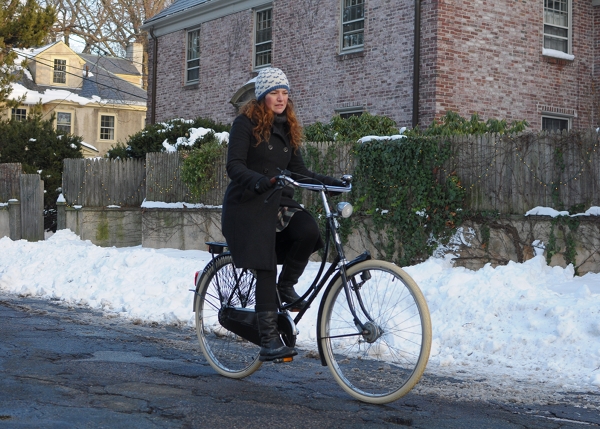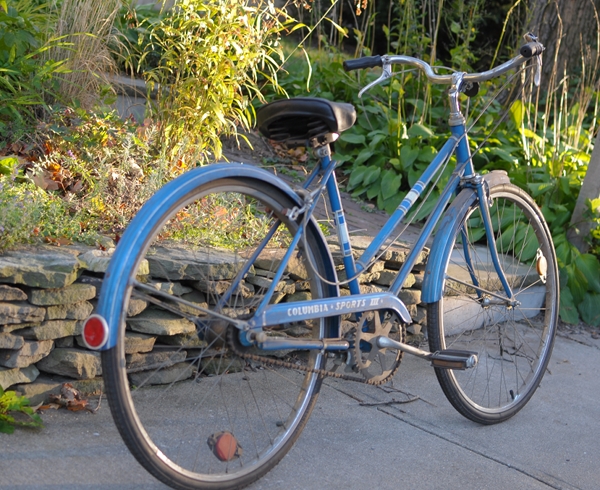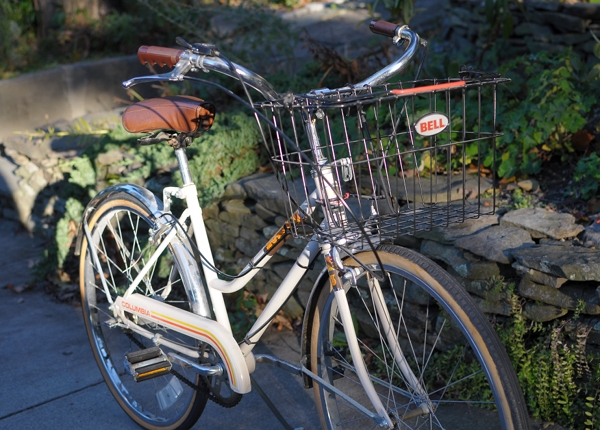 It was raining so hard, that I felt as if I was swimming rather than cycling: I had to keep wiping water off of my face. Between the darkness and the rain, it all looked like an impressionist painting.
It was raining so hard, that I felt as if I was swimming rather than cycling: I had to keep wiping water off of my face. Between the darkness and the rain, it all looked like an impressionist painting. Nonetheless, the ride itself was quite comfortable. Eustacia remained stable and easy to maneuver even through lake-sized puddles. The brakes worked perfectly. The lights shone brightly. I felt safe in traffic despite the wet conditions and the limited visibility. Once I got used to the feeling of water running down my face, it was even fun.
Nonetheless, the ride itself was quite comfortable. Eustacia remained stable and easy to maneuver even through lake-sized puddles. The brakes worked perfectly. The lights shone brightly. I felt safe in traffic despite the wet conditions and the limited visibility. Once I got used to the feeling of water running down my face, it was even fun. There were almost no other cyclists out, and one of the few I did see had an accident right in front of me: While turning a corner, she rode over some leaves and her bicycle flipped sideways. I knew that this could happen, but have never experienced it or seen it. She was cycling slowly, and it still happened. The cyclist was not hurt (I stopped to make sure she was all right), but still - falling like that could not have been pleasant. It seems that wet leaves really are extremely slippery and it is important to avoid them, especially when cornering.
There were almost no other cyclists out, and one of the few I did see had an accident right in front of me: While turning a corner, she rode over some leaves and her bicycle flipped sideways. I knew that this could happen, but have never experienced it or seen it. She was cycling slowly, and it still happened. The cyclist was not hurt (I stopped to make sure she was all right), but still - falling like that could not have been pleasant. It seems that wet leaves really are extremely slippery and it is important to avoid them, especially when cornering.The fallen cyclist was riding a diamond-frame bike, with tires that looked narrow and worn out. She expressed admiration for my Pashley and said that on a bike like that she bets this would not have happened to her. I am not so sure, as I have heard of people slipping on wet leaves and metal grates even on mountain bike tires. Still, I was acutely aware of how much of a luxury my tank of a bike was on a horrible day like this. I was comfortable, whereas the few other cyclists out there looked like they were miserable - struggling against the elements as well as their bikes' limitations.
 Here we are together in the rainy darkness. Not very flattering to either of us, but it captures the mood. My true all-weather friend. I must not forget this the next time I compare her to faster and more nimble bikes.
Here we are together in the rainy darkness. Not very flattering to either of us, but it captures the mood. My true all-weather friend. I must not forget this the next time I compare her to faster and more nimble bikes.
 There was aninteresting postonecoveloyesterday, where the author compared how he uses his three transportation bikes: aRivendellSam Hillborne, aSurlyLong Haul Trucker, and aCiviaLoring. All three bicycles are set up with upright handlebars and decent load carrying capacity, but the Civia differs from the other two in that it has a fairly low stepover. And according to the author, the combination of its "upright riding position, step-through frame, and internal gear hub make[s] the Loring exceptionally confidence inspiring for riding slowly when in close proximity to pedestrians and automobile traffic." Initially, I read past that sentence with the kind of matter-of-fact acceptance that goes with processing what you already consider to be a given. Butthen later I mentally "rewound" and thought "Wait a minute, he is saying that he finds it more comfortable to ride a step-through in traffic than a diamond frame - Is this a generally accepted notion?"
There was aninteresting postonecoveloyesterday, where the author compared how he uses his three transportation bikes: aRivendellSam Hillborne, aSurlyLong Haul Trucker, and aCiviaLoring. All three bicycles are set up with upright handlebars and decent load carrying capacity, but the Civia differs from the other two in that it has a fairly low stepover. And according to the author, the combination of its "upright riding position, step-through frame, and internal gear hub make[s] the Loring exceptionally confidence inspiring for riding slowly when in close proximity to pedestrians and automobile traffic." Initially, I read past that sentence with the kind of matter-of-fact acceptance that goes with processing what you already consider to be a given. Butthen later I mentally "rewound" and thought "Wait a minute, he is saying that he finds it more comfortable to ride a step-through in traffic than a diamond frame - Is this a generally accepted notion?"








 The last Iris bloom.
The last Iris bloom.  And a promise of things to come. Lovely Lillies.
And a promise of things to come. Lovely Lillies.




 Great Sand Dunes National Park & PreserveSouthwest Colorado, May 1979Copyright © 1979/.. by Rebeckah R. Wiseman
Great Sand Dunes National Park & PreserveSouthwest Colorado, May 1979Copyright © 1979/.. by Rebeckah R. Wiseman
























 A family member brought over a couple of old bikes to see whether I could sell them.The bikes came from the basement of an old property, and had been sitting there for several decades. They are in good condition, but nothing remarkable: Both are steel Columbia 3-speeds - most likely from the '80s. My plan was to post them on C-List and I had no intention to write about them here... But while snapping the photos, my imagination got the best of me and I started thinking about the bicycles' history.
A family member brought over a couple of old bikes to see whether I could sell them.The bikes came from the basement of an old property, and had been sitting there for several decades. They are in good condition, but nothing remarkable: Both are steel Columbia 3-speeds - most likely from the '80s. My plan was to post them on C-List and I had no intention to write about them here... But while snapping the photos, my imagination got the best of me and I started thinking about the bicycles' history. The smaller of the two has 24" wheels and appears to be a children's bike. The larger one has 26" wheels, but the small frame suggests that it too probably belonged to a young person - maybe the teenage sister of the cream bicycle's pre-teen owner? I can picture them cycling together down a sleepy suburban street, trying to make it home in time for dinner - one on the cream bike, the other on the blue, their delighted squeals rising above the clicking of the hubs...
The smaller of the two has 24" wheels and appears to be a children's bike. The larger one has 26" wheels, but the small frame suggests that it too probably belonged to a young person - maybe the teenage sister of the cream bicycle's pre-teen owner? I can picture them cycling together down a sleepy suburban street, trying to make it home in time for dinner - one on the cream bike, the other on the blue, their delighted squeals rising above the clicking of the hubs... In addition to its smaller size, there is something about the little cream bicycle in particular that evokes gentle images of childhood and its possibilities - maybe the soft, delicate colour.
In addition to its smaller size, there is something about the little cream bicycle in particular that evokes gentle images of childhood and its possibilities - maybe the soft, delicate colour. I wonder how typical it is - if at all - for parents today to pick up vintage children's bikes for their kids and restore them, instead of buying modern ones. Based on what I have seen, not very typical. Limited availability is probably a big reason: I don't actually see many children's vintage bikes around, even in Boston.
I wonder how typical it is - if at all - for parents today to pick up vintage children's bikes for their kids and restore them, instead of buying modern ones. Based on what I have seen, not very typical. Limited availability is probably a big reason: I don't actually see many children's vintage bikes around, even in Boston. Speaking of twenty years ago... I was 11 then, and riding something not too different from these bikes - as was my younger sister. That could be why I felt compelled to photograph these in a golden light, and to wonder about their history.
Speaking of twenty years ago... I was 11 then, and riding something not too different from these bikes - as was my younger sister. That could be why I felt compelled to photograph these in a golden light, and to wonder about their history.